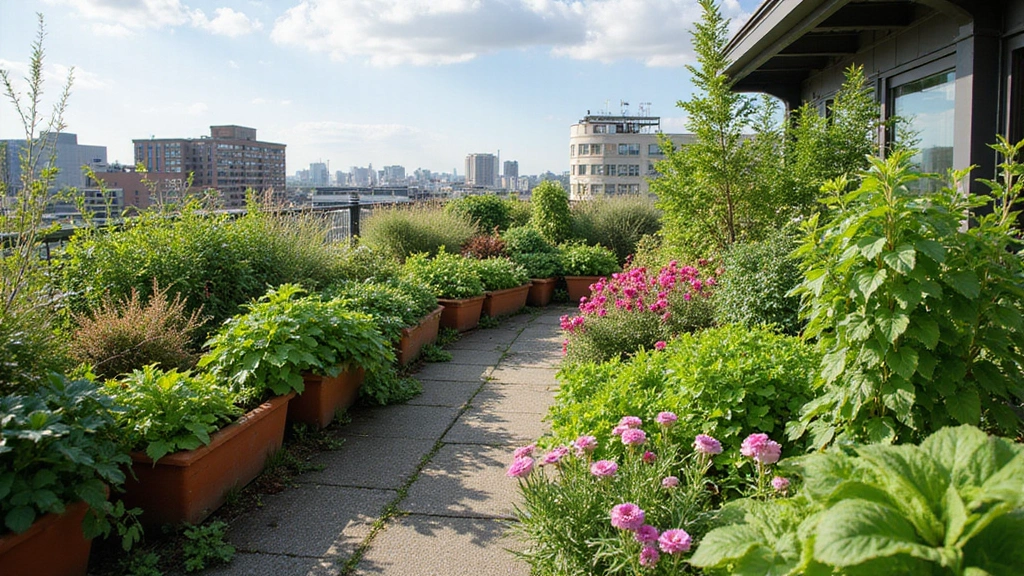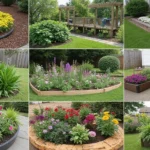Rooftop gardens are the perfect blend of nature and urban living, offering a serene escape from the hustle and bustle of city life.
Whether you have a sprawling rooftop terrace or a cozy balcony, these gardens can elevate your outdoor experience.
From lush herb gardens to minimalist landscapes, there’s a rooftop idea for everyone, regardless of space. Get ready to transform your urban rooftop into a chic, green oasis with these 30 vibrant ideas!
1. Herb Haven

Creating a rooftop herb garden can be both practical and beautiful. Imagine fresh basil, mint, and rosemary at your fingertips!
Choose a variety of herbs that thrive together, and use containers to keep things organized. Opt for stylish pots or vertical planters to maximize your space while making a statement.
Herbs not only add flavor to your meals but also infuse your outdoor space with delightful scents. Don’t forget to include some edible flowers like nasturtiums for a pop of color and culinary flair!
Herbs generally need 6-8 hours of sunlight daily, so pick a sunny spot. Also, ensure pots have drainage holes to avoid root rot.
2. Cozy Lounge Area

Transform a corner of your rooftop into a cozy lounge area for relaxation with comfortable furniture.
Consider using weather-resistant couches or a hammock with plush cushions to create a welcoming vibe. Add small side tables for drinks and snacks and don’t shy away from incorporating fairy lights or lanterns for mood lighting as evening falls.
This space can become your favorite retreat, perfect for reading, enjoying a morning coffee, or watching the sunset. Use planters around the seating area to create a natural boundary and enhance privacy.
Look for multi-functional furniture, like ottomans that double as storage, to keep your space uncluttered.
3. Vertical Gardens

Elevate your gardening game with vertical gardens that maximize limited space.
These gardens can be made with wall-mounted planters or trellises, allowing you to grow everything from flowers to vegetables without taking up precious floor space.
Vertical gardens not only save space but also add a visually striking element to your rooftop design. Choose climbing plants like peas or vines for a lush, green wall effect. For best results, select plants that have similar sunlight and watering needs to ensure they thrive together.
Consider using recycled materials like pallets for a rustic-chic look.
4. Sustainable Living

Integrate sustainable elements into your rooftop garden for an eco-friendly escape.
Start by collecting rainwater in barrels for irrigation, or consider installing a green roof system with native plants that require minimal maintenance. You can also implement composting bins to turn kitchen scraps into nutrient-rich soil for your plants.
Sustainable gardening fosters biodiversity and can help reduce urban heat. Choose local, native plants to attract beneficial insects, such as bees and butterflies, creating a thriving ecosystem right above the city.
Look into solar-powered garden lights to illuminate your rooftop sustainably at night.
Sustainability is more than a trend; it’s a lifestyle! By incorporating native plants and composting, your rooftop garden can thrive while giving back to the Earth. Let’s grow together for a greener, cleaner urban space!
5. Water Features

Incorporating a small water feature can turn your rooftop into a tranquil oasis.
Consider adding a small fountain or a pond in a container that attracts birds and creates soothing sounds. Water features not only enhance the aesthetic appeal but also help cool the air around your space.
Choose materials that blend with your existing decor, whether it’s a natural stone fountain or a sleek modern design. Ensure that the feature is easy to maintain and doesn’t attract unwanted pests.
Surround your water feature with plants that thrive in moist conditions, like ferns or water lilies, for added beauty.
6. Edible Landscaping

Combine beauty and utility in your rooftop space through edible landscaping.
Imagine a garden where every plant is not only pleasing to the eye but also delicious! Incorporate fruit trees in pots, berry bushes, and edible flowers alongside traditional ornamental plants. This design philosophy allows you to cultivate a visually stunning garden that doubles as a food source.
Choose dwarf varieties of trees to fit your space, and remember to plant herbs and vegetables that complement each other. Not only can you enjoy harvesting, but you’ll also have a gorgeous garden to admire every day.
Plan your layout in advance to ensure optimal sunlight and growth conditions for each plant type.
7. Container Gardening

Container gardening is a fantastic option for those with limited space on their rooftops.
Use pots, hanging baskets, and window boxes to create unique arrangements that fit your style. Mix up sizes and heights for a dynamic display that draws the eye. Choose containers made from lightweight materials for easy rearrangement, and don’t forget to select plants that thrive in your climate.
This method allows you to control soil quality and drainage, ensuring your plants flourish. Besides, it’s an easy way to change your garden’s look seasonally.
Group pots together for a fuller effect and to create micro-climates for your plants.
8. Rooftop Greenhouse

A rooftop greenhouse can extend your growing season and protect plants from harsh elements.
These structures come in various sizes and styles, allowing for customization to fit your rooftop perfectly. You can grow a range of plants year-round, from tropical plants to vegetables. A greenhouse also helps to regulate temperature and humidity, creating an ideal environment for growth.
Incorporate shelving for pots and vertical growing systems to utilize space efficiently. For added charm, consider using clear materials to allow natural light in while keeping out pests.
Ensure your roof can support the weight of the greenhouse structure before installation.
9. Outdoor Dining Area

Create a space for al fresco dining that’s perfect for hosting friends and family.
Set up a table with comfortable chairs, perhaps even a built-in bench surrounded by greenery. Adorn the area with outdoor-friendly tableware and string lights for a cozy ambiance. You can make it even more inviting with planters full of herbs and flowers, which can also serve as fresh garnishes for meals.
This setup not only elevates your rooftop experience but also encourages outdoor socializing. Dress the table with seasonal decor for special gatherings.
Consider weather-resistant furniture for durability and maintain a theme that complements your garden design.
10. Cozy Firepit

Add a touch of warmth and coziness to your rooftop with a firepit.
This feature can be a focal point for gathering, providing a perfect spot for roasting marshmallows or enjoying cool evenings under the stars. Select a portable firepit if you want flexibility, or choose a built-in model for a permanent feature. Surround the firepit with ample seating to create an inviting atmosphere.
Consider adding decorative stones or gravel around the fire area to enhance the look. Don’t forget safety measures, especially if you’re on a rooftop.
Keep your firepit stocked with firewood or charcoal for easy access and add outdoor cushions for extra comfort.
11. Shade Solutions

Sun protection is key for enjoying your rooftop garden on warm days.
Consider installing a pergola or retractable awning to provide shade where needed. You can also use large umbrellas or natural shade from taller plants. This allows you to create comfortable areas for lounging and gardening without the uncomfortable heat.
Incorporate climbing plants on your pergola for a dynamic natural canopy. For aesthetic appeal, choose colors and materials that align with your garden theme.
Make sure your shade solutions are sturdy enough to withstand wind and rain.
12. Wildlife Haven

Designing your rooftop garden with wildlife in mind can enhance its charm and ecological value.
Choose native plants that attract birds, butterflies, and beneficial insects. Creating shelter spots with dense foliage and using bird feeders can encourage wildlife visits. Consider incorporating a bee hotel to support pollinator populations. Not only will you enjoy watching these creatures, but you’ll be contributing to urban biodiversity.
Keep a naturalistic design to allow wildlife to feel at home.
Avoid using chemical pesticides and fertilizers to maintain a safe environment for your garden guests.
Create a rooftop garden that welcomes wildlife – choose native plants and build cozy spots for birds and bees. You’ll not only beautify your space but also become a champion for urban biodiversity!
13. Seasonal Themes

Planning seasonal themes in your rooftop garden keeps the space fresh and exciting.
As seasons change, swap out plants and decor to reflect the current vibe. In spring, consider cheerful blooms, while autumn can bring in vibrant foliage and pumpkins. You might change out your cushions and decor to match the season, creating a visually cohesive atmosphere.
This practice not only keeps your garden looking lively but also allows you to experiment with different plants and colors throughout the year.
Create a calendar to remind you of seasonal changes and plant swaps.
14. Eco-Friendly Materials

When designing your rooftop garden, consider using eco-friendly materials for sustainable living.
Look for recycled planters, rain barrels made from repurposed materials, and organic soil amendments. Using sustainable materials reduces your environmental footprint and often gives your garden a unique, rustic appearance. Incorporating reclaimed wood for raised beds or benches adds character and charm.
This approach allows you to create an eco-conscious space while supporting local artisans and businesses.
Research local suppliers that specialize in organic and sustainable gardening products.
Choose eco-friendly materials for your rooftop garden – it’s not just good for the planet but also adds unique charm! Reclaimed wood and recycled planters can turn your space into a sustainable haven.
15. Colorful Container Displays

Utilize colorful containers to make your rooftop garden pop!
Mix and match different pot styles, sizes, and colors to create an eye-catching arrangement. This approach adds a playful touch and allows you to express your personality through your garden design. Choose flowering plants and foliage in various shades to create vibrant contrasts. For a cohesive look, you can also select a dominant color theme for your plants.
Grouping pots together creates visual interest while maximizing growth space.
Use self-watering pots for convenience and to maintain hydration levels.
16. Aromatic Plants

Incorporating aromatic plants into your rooftop garden can enhance your outdoor experience.
Plants like lavender, rosemary, and lemon balm not only look great but also fill the air with delightful scents. These plants can create a calming atmosphere, perfect for relaxation. You can also use aromatic herbs in cooking, making them functional as well as decorative. Pair aromatic plants with other garden features like seating areas for a multi-sensory experience.
Consider growing aromatic plants in terracotta pots to help retain moisture.
17. Artistic Touches

Add artistic elements to your rooftop garden to make it a personalized retreat.
Incorporate sculptures, garden art, or handcrafted decor that resonates with your style. A unique bird bath or whimsical wind chimes can draw attention and elevate the garden’s aesthetic. Combining art with nature creates a harmonious environment that inspires creativity. Choose pieces made from natural materials to enhance the organic feel of your garden.
Rotate art pieces seasonally for a fresh look and to keep your space dynamic.
18. Lighting Options

Lighting is essential for creating ambiance in your rooftop garden, especially for evening gatherings.
Consider solar-powered lanterns, string lights, or LED spotlights to highlight specific plants or areas. Soft lighting can transform your space into a magical retreat at night. Opt for dimmable options to adjust the ambiance according to occasions. Be creative with the placement of lights—wrap them around trees or drape them across seating areas.
Use timers to automate lighting for convenience and energy efficiency.
19. Garden Pathways

Designing pathways in your rooftop garden can add structure and flow to your space.
Use gravel, stone, or even wooden planks to define walking areas. Pathways guide visitors through the garden and can enhance aesthetic appeal by providing contrast with plants. You can also incorporate stepping stones surrounded by ground-cover plants for a more organic feel. Clear pathways contribute to safety and ease of movement, especially when carrying gardening supplies or refreshments.
Make pathways wide enough to accommodate gatherings and ensure they connect key areas of your garden.
20. Seasonal Planting

Rotate your plants seasonally to keep your rooftop garden vibrant and thriving.
Incorporate annual flowers, seasonal vegetables, and herbs to create a colorful display throughout the year. Consider planting bulbs in the fall for spring blooms, or leafy greens in the cooler months for a fresh harvest. This practice extends the visual appeal of your garden and allows you to experiment with different plants as seasons change.
Planning your seasonal garden can be a fun project to engage family and friends.
Keep a gardening journal to note what grows well in each season, helping you refine your plant selection over time.
21. Privacy Screens

If city life feels too exposed, consider adding privacy screens to your rooftop garden.
Use trellises covered with climbing plants, such as ivy or clematis, to create natural screens that enhance seclusion. Bamboo or tall planters can also serve as effective barriers while adding beauty to your design. These features can help define your space and provide a sense of intimacy for gatherings or quiet moments. Ensure that screens don’t block too much sunlight; opt for plants that allow some light to filter through.
Include seating behind your privacy screens for a cozy retreat feeling.
22. Multi-Level Design

For larger rooftops, a multi-level design can add depth and interest to your garden.
Use platforms, steps, or tiered planters to create different levels of planting, allowing for a variety of plants and flowers. This not only maximizes space but also enhances the visual impact of your garden. Different heights can accommodate various light needs, so you can customize the plant selection based on their requirements. Create a flow between levels to encourage exploration and create a layered look.
Incorporate railings or barriers for safety, especially if using elevated structures.
23. Community Spirit

If you’re part of a building or neighborhood, consider collaborating on a community rooftop garden.
This can turn your shared space into a hub for gardening enthusiasts and foster a sense of community. You can share resources, tools, and knowledge, while collectively creating a lush green space. A community garden encourages social interaction and learning opportunities, making gardening accessible to everyone involved. Collaborate on plant selection to ensure a diverse garden.
Organize regular meetups to discuss garden progress and plan activities together.
24. Artistic Planters

Choose unique and artistic planters to add personality to your rooftop garden.
From recycled objects like teacups to modern geometric designs, the options are endless. Artistic planters can become conversation starters and add flair to your garden while serving a practical purpose. Mixing different styles can create an eclectic vibe that reflects your taste. Consider grouping pots with similar colors or textures for a cohesive look.
Regularly change out plants in artistic planters to keep the design dynamic and evolving.
25. Mobile Gardens

Mobile gardens can offer flexibility in your rooftop space, allowing you to rearrange plantings as needed.
Using wheeled planters or movable raised beds lets you shift plants to maximize sunlight or change aesthetics easily. You can also create portable herb gardens that can be moved closer to your kitchen for easy access. This feature is especially useful for seasonal gardens, allowing you to showcase different plants throughout the year.
Ensure that wheeled planters are sturdy and have locking mechanisms for safety during windy days.
Flexibility is the secret ingredient of a stunning rooftop garden. With mobile gardens, you can dance with the sunlight and change your scenery every season – making your urban retreat as fresh as your herbs!
26. Green Roof Systems

Explore installing a green roof system to create a lush landscape on top of your building.
These systems involve layers of plants and soil that absorb rainwater and provide insulation. A green roof can reduce energy costs and improve air quality in urban areas while offering a vibrant habitat for wildlife. Choose low-maintenance, drought-resistant plants that are suitable for your climate to ensure long-term success. This extensive garden idea not only beautifies your space but also contributes positively to the environment.
Consult with professionals to design a system that suits your building’s structure and local regulations.
27. Garden Workshops

Hosting workshops on your rooftop garden can turn it into a community hub for learning and sharing.
Invite local experts to teach about gardening techniques, sustainability, or cooking with fresh herbs. These workshops not only foster a sense of community but also provide valuable skills and knowledge. You can organize seasonal events for different topics, making it a dynamic gathering space.
Promote your workshops through social media to attract a diverse group of participants.
28. Outdoor Art Installations

Incorporate outdoor art installations in your rooftop garden to enhance visual appeal and creativity.
Choose art pieces that resonate with your personal style or community themes. Sculptures, murals, or even interactive art can become key focal points while blending beautifully with natural greenery. This unique combination adds depth and intrigue, inviting exploration and conversation. Ensure the artwork is weather-resistant to maintain its beauty through the seasons.
Rotate your art installations periodically to keep the garden feeling fresh and exciting.
29. Aromatherapy Plants

Enhance your rooftop experience with plants known for their aromatic properties, which promote relaxation and well-being.
Plants like chamomile, mint, and eucalyptus can create a soothing environment while also providing culinary benefits. Arrange them in a designated area of your garden, and consider incorporating pathways lined with these aromatic plants for an immersive sensory experience. These plants can also be used in teas or as natural remedies, adding functionality to your garden.
Regularly harvest leaves to enjoy fresh herbal teas while keeping plants healthy and thriving.
30. Rooftop Yoga Space

Designate a section of your rooftop for yoga or meditation practice that combines the serenity of nature with the tranquility of your garden.
Use soft mats, cushions, and serene decor to create a peaceful oasis. Surround the area with calming plants and perhaps a small fountain for soothing sounds. This dedicated space encourages mindfulness and relaxation while enjoying the fresh air. You can also invite friends for group sessions or host yoga classes to create community.
Choose plants with calming scents like lavender or jasmine to enhance the peaceful atmosphere.
Conclusion

With these 30 rooftop garden ideas, you can transform your urban space into a chic and relaxing escape that caters to your style and needs.
Whether you’re interested in gardening, entertaining, or simply unwinding, there’s an idea here to inspire your rooftop renovation. Engage with your space and let your creativity blossom!
Frequently Asked Questions
What are some essential tips for starting a rooftop herb garden?
Starting a rooftop herb garden is easier than you might think! First, choose a sunny spot, as most herbs thrive in at least 6 hours of sunlight daily. Opt for container gardening to maximize space; use pots with good drainage to prevent overwatering.
Mix herbs that complement each other, like basil, mint, and rosemary. Don’t forget to regularly harvest your herbs for the best growth and flavor. And remember, urban gardening can be both beautiful and practical!
How can I create a cozy lounge area on my rooftop?
Transforming your rooftop into a cozy lounge is all about comfort and style! Start by selecting weather-resistant furniture like cushioned sofas or hammocks. Consider adding soft throws and pillows for an inviting touch.
Incorporate greenery through potted plants or trellises to create a serene atmosphere. Don’t forget soft lighting! String lights or lanterns can add a magical glow, making it the perfect spot for relaxation or entertaining in your outdoor living space.
What are the benefits of incorporating vertical gardens in urban gardening?
Vertical gardens are a fantastic solution for maximizing limited space in urban settings! They not only add visual interest to your rooftop but also improve air quality and provide insulation.
Using wall-mounted planters or trellises, you can grow herbs, flowers, or even vegetables, making your garden both beautiful and functional. Plus, they encourage biodiversity and can create a charming rooftop landscaping effect that delights both you and your neighbors!
How can I make my rooftop garden eco-friendly?
Creating an eco-friendly rooftop garden is a rewarding endeavor! Start by using recycled materials for planters and furniture. Incorporate rainwater collection systems for irrigation to conserve water.
Choose native plants that require less maintenance and attract local wildlife, enhancing your garden’s ecological value. Consider installing a green roof system to insulate your building and promote biodiversity. Small steps can lead to a sustainable urban oasis!
What kind of plants are best suited for small rooftop gardens?
For small rooftop gardens, opt for plants that thrive in containers and can handle the elements. Herbs like basil, thyme, and parsley are excellent choices for their practicality and beauty.
Consider colorful flowers like geraniums and petunias for a pop of color, or even small fruit plants like strawberries or dwarf varieties of tomatoes. Remember, small space gardening is all about creativity—mix and match plants to create a vibrant, lush retreat in your urban environment!






